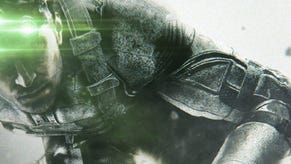Splinter Cell: Blacklist Review
Sam Fisher returns in a brand-new Splinter Cell, but Sam's choices are secondary to your choices.
This article first appeared on USgamer, a partner publication of VG247. Some content, such as this article, has been migrated to VG247 for posterity after USgamer's closure - but it has not been edited or further vetted by the VG247 team.
Primary Reviewer, Mike Williams
Splinter Cell: Blacklist is Ubisoft Toronto's massive AAA love letter to the entire Splinter Cell series. The game isn't a sandbox, but it is about providing you with a wealth of options to achieve Sam Fisher's goals. Strike that: a wealth of options to achieve your goals. Because at its core, Splinter Cell: Blacklist asks you who you are as a player.
Blacklist's gameplay comes at you in three different flavors. Ghost focuses on not being seen or taking down your foes using non-lethal methods without them raising an alarm. This playstyle is roughly analogous to Splinter Cell: Chaos Theory, the series' standout for classic players. Panther sits near Ghost: you want to be stealthy, but the goal here is killing your opponents quietly. The Panther playstyle evokes Splinter Cell: Conviction, the series' action-oriented little brother. Finally, Assault is the open combat playstyle, seemingly aimed at those who love FPS titles like Battlefield and Call of Duty.
During missions, your actions will be scored in either of the three playstyles. Once you finish a mission, Ubisoft Toronto gets tricky. See, there are score multipliers for each playstyle and they sit on a sliding scale. Ghost actions have the highest multiplier, followed by Panther, and then Assault. Instead of forcing you to play Splinter Cell the "correct" way, they give you more love (and money) for doing so. Positive reinforcement! Personally, I didn't find Assault a viable playstyle because my Sam Fisher doesn't take too many hits before dying and upon detection I just reset to the last checkpoint.

If you were reading closely, you notice the "my" hidden there in front of "Sam Fisher". Outside of the three playstyles, the game provides a plethora of options. That money that you get for completing missions? You use that to buy gear. You can buy and customize your weapons, the bits of Sam's Ops Suit, your gadgets, and even change the color of your googles and stealth indicator light. Warning: the color purple costs the most.
My Sam Fisher was heavily invested in gadgets that would back up the Ghost and Panther playstyles. The Ops Suit pieces I purchased improved stealth and accuracy, not power and armor. I replaced the starting Assault Rifle with a Sniper Rifle as soon as possible. I'm a bit of a noob, so I upgraded my Night Vision Googles with a sonar mode, that recalled Conviction's ability to let you see through walls, but without the range or ability to see through all surfaces. You can actually purchase the latter part as an upgrade to the googles, I just I declined to do so. Grenades weren't a part of my gadget set, instead I stuck to the sticky lineup: sticky noisemaker, sticky emp, and sticky proximity shocker.
"My Sam Fisher" is an important distinction because your Sam Fisher is a completely different character with different reactions to situations. Your Fisher may use flash bangs, sprinting takedowns, and Mark and Execute to take down enemies quickly. Your friend's Fisher may be full up on grenades, the best armor, and powerful unsilenced guns. My Fisher alternated between non-lethal takedowns - you can switch between lethal and non-lethal takedowns in your weapons radial menu - capping enemies with my silenced pistol, taser, and sniper rifle. I rarely used Mark and Execute; the Mark feature was helpful in tagging enemies and keeping track of their position, but the Execute side wasn't my thing. I wasn't avoiding it, it just never fit into the flow of my game, except in a few clutch situations. That said, accidentally finding out I could Execute at long range using the Sniper Rifle was pretty boss.
You can also spend your earnings to upgrade Sam's new flying base of operations, the Paladin. The Paladin is home to Sam's new team and feels like the terrorist base from Splinter Cell: Double Agent, the series' forgotten child. Operations manager Anna Grimsdottir lets you upgrade the plane for a better radar, faster regeneration in the field, more prototype and black market weapons, and more loadout slots for Sam. Annoying hacker Charlie Cole lets you customize your gear (pro-tip: you can do this without talking to Charlie by walking over to your gear in the same room he occupies). New operative Issac Briggs, who's actually the second player if you choose to run co-op missions, tracks your stats and progress in the game.
Each of the team members on the Paladin offer their own side missions, which may be an even bigger draw than the campaign missions for some players. While some of the missions are co-op only, a number of them can be tackled solo or co-op. These side missions are fully-realized levels that task you with different objectives: take down all hostiles, make your way to specific points in the level, or defend an area against waves of enemies. The latter mission mode is interesting as it's rather fun to learn the layout of a level and hunt freely, but the size of the waves ramps up quickly. It starts off simple, but quickly becomes time-consuming and somewhat tedious.

And that sums up the missions in Splinter Cell: Blacklist: time-consuming and hard. This game does not play nice. It drops in twists to the formula pretty early. Dogs can smell Sam through doors and walls. Armored infantry can only be taken down from above or behind; a frontal takedown, even from around a corner, just causes them to push you away and unload a shotgun in your face. This is where Mark and Execute can help a bit: you can Mark these guys, use Execute to take off their helmets, and then take them down at your leisure. Even regular enemies can push away a stealthy frontal takedown occasionally if they're already alerted to your presence. Again, Blacklist doesn't force you to do things like hide your bodies, but it makes things subtly easier for you to follow the company line. Within a Blacklist level you won't have as many options as you did in Chaos Theory - I was disappointed the first time I saw a generator and found I couldn't shut it down and plunge the area into darkness - but it's pretty damn close.
All of these options, playstyles, and open levels add up to a customization experience. And that leads to back to the question of who you are. Are you a loud, brash, murderer? A silent ghost who harms no one? Do you kill dogs or just taze them? After Sam tortures someone for information - these sequences still happen, you're just not an active part of it - do you kill your victim or let them live? What kind of trained soldier would you be?
There's still a bit of dissonance in some of these interactions: it's hard to be completely empathic to the torture victim when you've probably shot six or seven enemies along the way. But delving into the situation does make you wonder. Why am I so against killing dogs, but shooting a human in the head is just another day at the job? What about the preceding torture makes me want to spare a victim's life? Why do I default to non-lethal takedowns, but shoot guards for expediency? These are questions I can't answer for you, and you may not even ask them of yourself, but they popped up for me. Blacklist never concretely comes out and says "this is how things should go" when it comes to moral choices; the characters are all over the map, leaving you to determine where you fall personally.
I haven't gone into the game's story because there's not much to go into. It's ham-fisted and goes out of its way to make things personal for Sam Fisher. Ubisoft, this is Sam's job, it doesn't need to be personal for him (or me) to be invested. I'm here for the stealth gameplay, that Lament Configuration where doing the wrong thing equals death. That gameplay is the real star of the show and you gave us that, so you don't need to try too hard otherwise.
Blacklist is a quality game and despite what some may think, it's clear that Ubisoft Toronto has a clear love for the Splinter Cell franchise up until this point. The game is caught between providing a hard stealth experience while reaching for a larger audience and it's a testament to Ubisoft's efforts that they pulled it off. While you'll occasionally be thrust into a 24-style action movie, for the most part the stealth roots are strong and deep. Splinter Cell: Blacklist isn't perfect, but it's a damn good start for a new series.
The Nitty Gritty
- Visuals: Splinter Cell: Blacklist is one of the most beautiful games out there; cities and outposts feature dust, weathered concrete, ramshackled homes, bright light, and inviting shadows.
- Music: Action movie fare that you probably won't remember outside of the game.
- Interface: The SMI interface on the Paladin is where you'll spend most of your time. It's well put-together and does the job admirably. Interacting with your allies to upgrade and customize Sam is annoying, but there are ways around that.
- Lasting Appeal: In addition to the lengthy solo campaign, you'll get a ton of side missions around the world. Spies vs. Mercs and co-op missions round out the multiplayer offerings.
ConclusionUbisoft has taken the best of Splinter Cell and packaged it in a great game that represents a new start for the series. If you love Splinter Cell, don't be afraid of a purchase.









